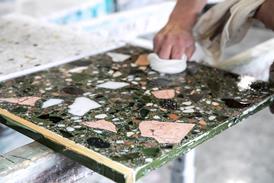Integer's timber-frame construction uses a kit from Guildway with striking thermal performances. The UK's current Building Regulations, soon to be made more demanding, now require walls to be built to given U-values (the standard measurement for heat loss). The guidance figure is not more than 0.4 W/m²K - the lower the figure the harder for heat to pass through. Integer walls outperform the target by at least 100%, being 0.19 W/m²K. Guildway's kit has thick studwork creating wall cavities of 195 mm compared with a common 89 mm.
Wooden kits from managed sources score well under environmental sustainability criteria - mature trees cut down to supply timber will have finished growing and so stopped being net consumers of CO2, but the saplings then planted to replace them will be hungry consumers of CO2 as they grow to maturity.
But the most ecology-minded aspect of the house's wall construction is its insulation. Excel Industries' Warmcel 500 cellulose fibre is recycled newspaper, pulped and then treated with organic fire retardants before being sprayed on site to fill the cavity between the sheathing boards sandwiching the structural walls.
There are three other details worth noting in the section drawing. First, the MDF skirting board is removable by unscrewing it and hides a duct for accommodating cabling. This allows householders to modify power and IT arrangements. Second, because timber joist floors are now losing out to concrete beams and blocks as buyers ask for better sound proofing of first floors, floorboards in the house are laid on Dynamic acoustic battens from Proctor Group which shock absorb impact sound - mostly footfalls. A second device, jointing between wall and floor of 5 mm insulation to cut sound transmission, is aimed at the problem in both timber and concrete floors of "sound flanking" - noise from one floor travelling up or down along the wall of a building.
Source
Building Homes




















